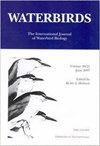栖息地点对亚利桑那州和加利福尼亚州沙丘鹤生境选择的影响
IF 0.6
4区 生物学
Q3 ORNITHOLOGY
引用次数: 1
摘要
干旱半干旱区湿地被认为是湿地依赖物种优先保护的生态系统。对生境选择的评价对于有效的生境管理和种群管理是必要的。科罗拉多河谷下游大沙丘鹤(Antigone canadensis tabida)的种群,只在亚利桑那州西南部和加利福尼亚州东南部的部分地区过冬。因此,需要有关冬季栖息地选择的信息来指导管理决策。我们将太阳能卫星平台发射机终端安装在沙丘起重机上,并使用每日全球定位系统定位。每个使用的位置与10个随机生成的位置配对,绘制任意随机生成的位置的概率相等。结果表明,考虑土地利用类型(β = -5.85, SE = 0.23, P < 0.001)和栖息地距离(β = -4.61, SE = 0.16, P < 0.001)的交互效应模型是候选集中最受支持的模型。我们的研究结果强调了在选定的土地利用类型附近(~ 5公里)维持湿地的重要性,这在干旱系统中可能具有挑战性,但对于这种高度保护优先的大沙丘鹤种群尤其必要。本文章由计算机程序翻译,如有差异,请以英文原文为准。
Roost Sites Influence Habitat Selection of Sandhill Cranes (Antigone canadensis tabida) in Arizona and California
Wetlands in arid and semiarid regions are recognized as priority ecosystems for conservation of wetland-dependent species in these systems. Evaluation of habitat selection is necessary for effective habitat management and, consequently, population management. The Lower Colorado River Valley population of Greater Sandhill Cranes (Antigone canadensis tabida), winters exclusively in portions of southwestern Arizona and southeastern California. Therefore, there is a need for information pertaining to winter habitat selection to guide management decisions. We attached solar-powered satellite platform transmitter terminals to greater Sandhill Cranes and used daily global positioning system locations. Each used location paired with 10 randomly generated locations had equal probability of drawing any of the randomly generated locations. We evaluated habitat selection and found the model that included land use type (β = –5.85, SE = 0.23, P < 0.001) and distance to roost (β = –4.61, SE = 0.16, P < 0.001) as interactive effects was the most supported model in the candidate set. Our results emphasize the importance of maintaining wetlands in close proximity (∼ 5 km) to selected land use types, which can be challenging to manage for in arid systems but are particularly necessary for this high conservation priority population of greater Sandhill Cranes.
求助全文
通过发布文献求助,成功后即可免费获取论文全文。
去求助
来源期刊

Waterbirds
生物-鸟类学
CiteScore
1.30
自引率
0.00%
发文量
0
审稿时长
6-12 weeks
期刊介绍:
Waterbirds is an international scientific journal of the Waterbird Society. The journal is published four times a year (March, June, September and December) and specializes in the biology, abundance, ecology, management and conservation of all waterbird species living in marine, estuarine and freshwater habitats. Waterbirds welcomes submission of scientific articles and notes containing the results of original studies worldwide, unsolicited critical commentary and reviews of appropriate topics.
 求助内容:
求助内容: 应助结果提醒方式:
应助结果提醒方式:


